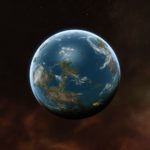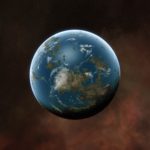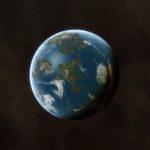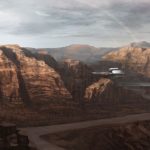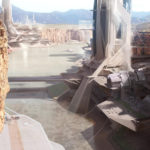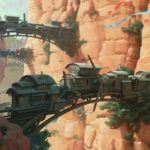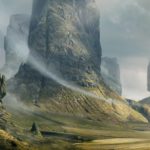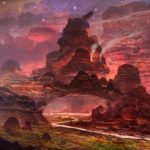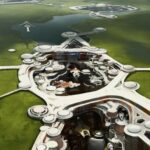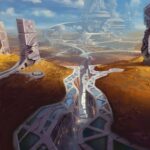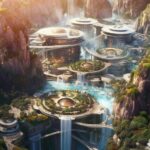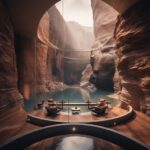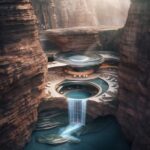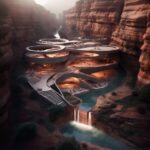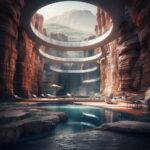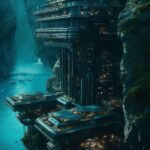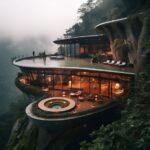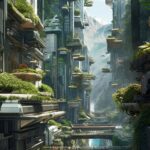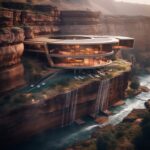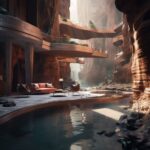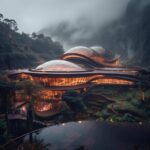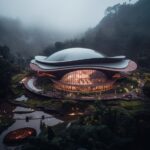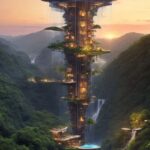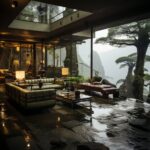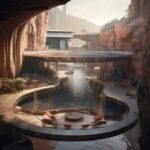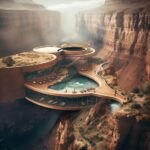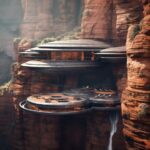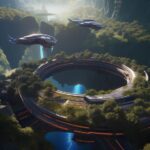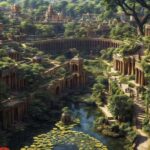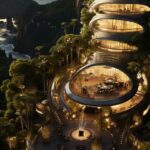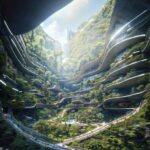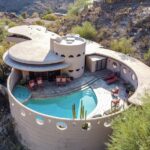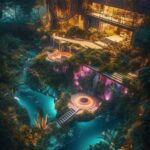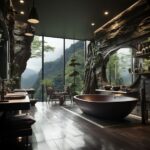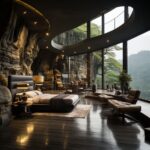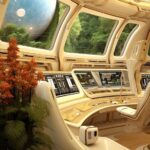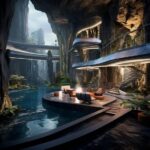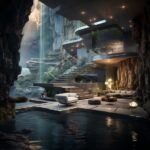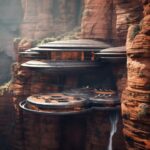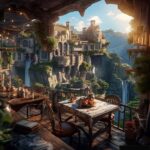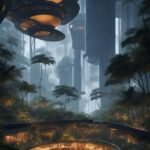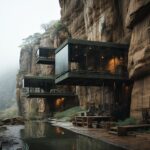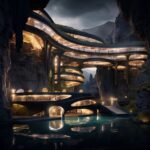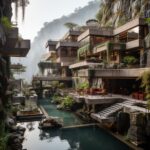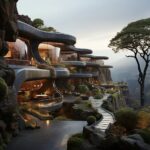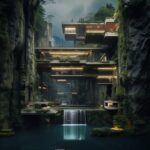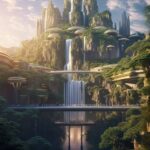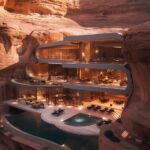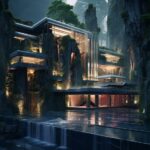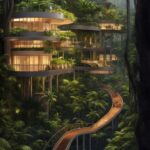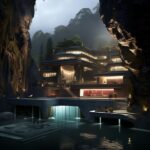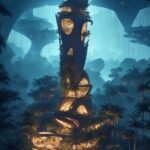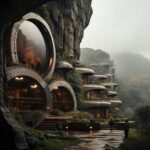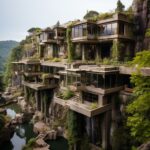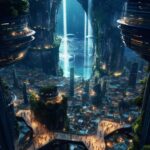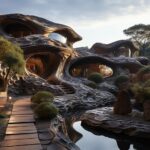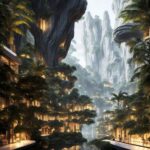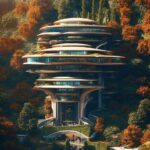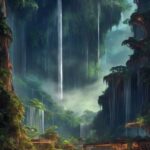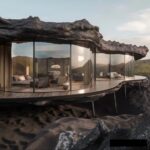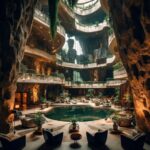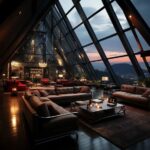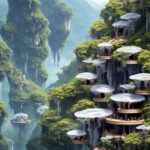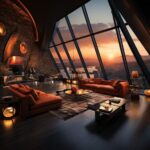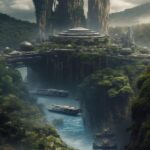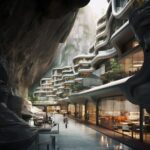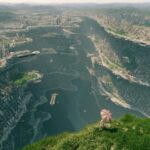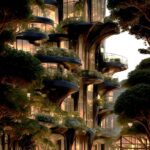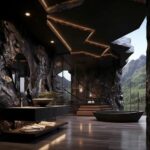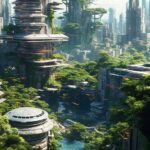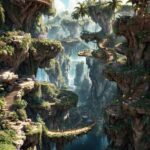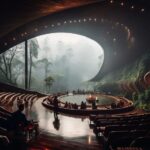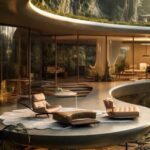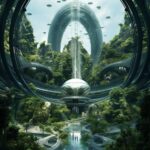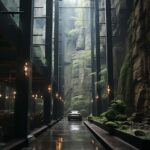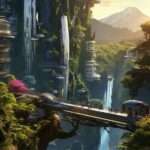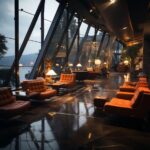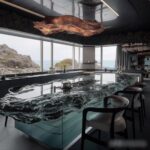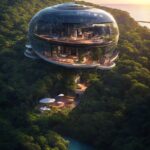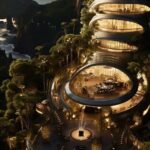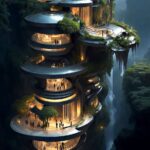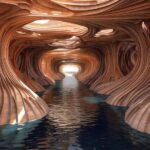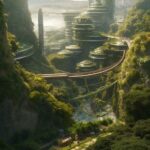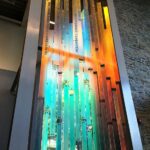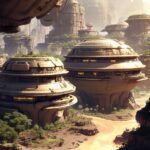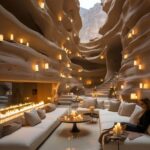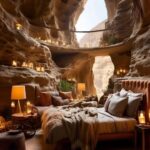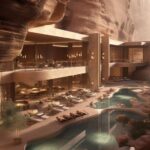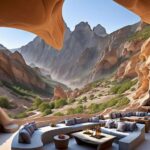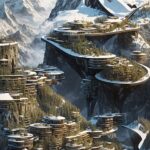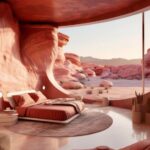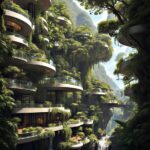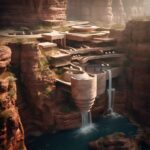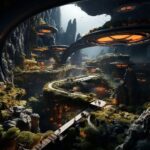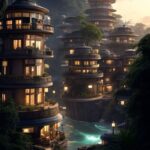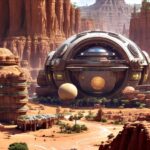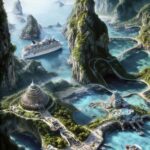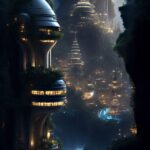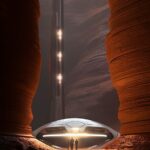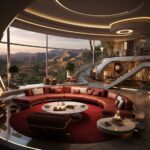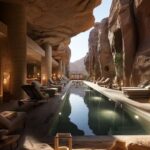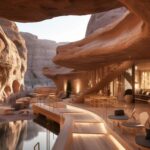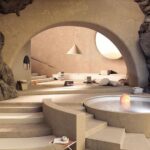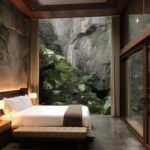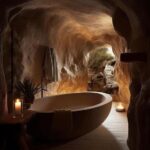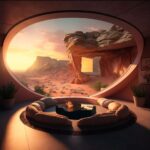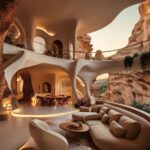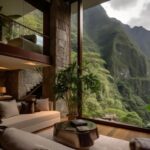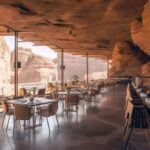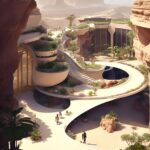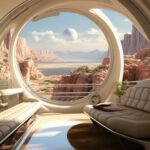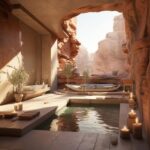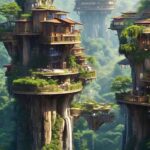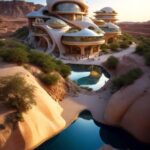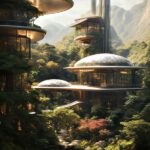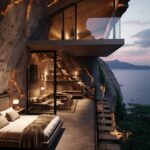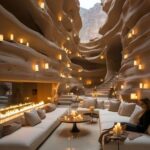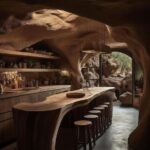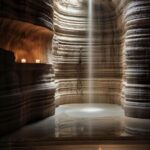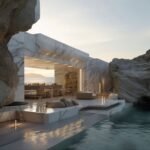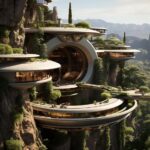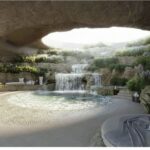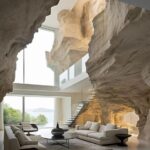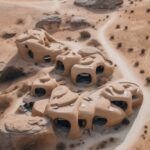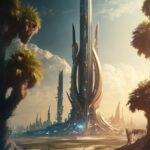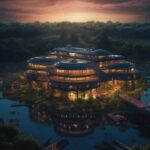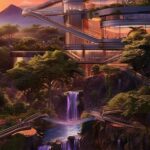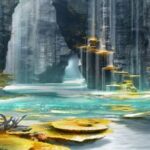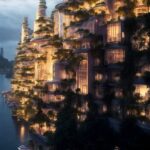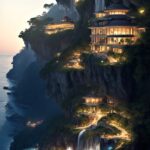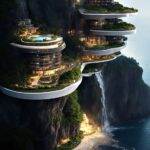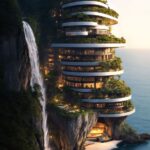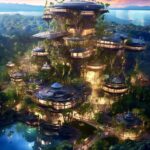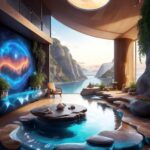This is where Zed’ was born and raised.
–
Table of Contents:
- Planet Info (Corrected from CCP Errors/Randomness)
- Planet-side Description
- Place-names Explanation
- Population Over Time
- Views from High-orbit (Images Begin)
- Colonization Progress
- Views of the Canyons
- 2023 July Update: Views Beyond the Canyon-cities
–
Planet Info:
In the game EVE Online, the information pop-ups about planets, moons, and asteroid belts used randomly generated numbers that did not make sense; sometimes the posted distance between a planet and one of its moons was greater than the distance of that planet from its star. Thus you will find different numbers here than the ones in EVE Online.
- intermediate age
- solid/stable
- dimensions, gravity, and atmosphere comparable to Earth‘s
- multiple moons, only some recognized as proper/stable natural-satellites by the Amarr
- mostly oceanic, but with numerous sizable continents
- many / nearly all biomes and climate-zones
- “garden world”; Class M on the Starfleet classification system
- great variety of flora and fauna
- indefinite weather pattern which is an equatorial storm-system apparently ‘orbiting’ within that latitudes-band
- colonized by humans from the Milky Way millennia ago
- many artificial-looking cave-tunnels, mostly in/under its main/C-shaped continent (where the first wave of colonization was focused)
–
Planet-side Description:
You probably have never heard of me. That’s the way I and my people like to keep it, though –but not for any shadowy or disreputable reason you might think. We just know the value of being ‘grey men’; little else affords one any real measure of peace and quiet, especially with all the overlapping conflicts and blood feuds going on.
My father named me Zedicon, and it turned out my name would sound appropriate for what my life, dare I call it destiny, had in store; I was the last of his planned children, as well as the one out of them all who would help bring an agreeable end to so many controversial stories involving the unwanted liberation of some of our slaves… and the slaves of our neighbors and friends. The final letter in the alphabet, or the final word or ‘say’, my name forever hints at who I am out here and what I do. When one of our people’s stories has endured an unexpected addition, such as contact with Minmatar kidnappers, they send me in to get things back the way everyone over here desires them to be.
Soliara III has two registered moons if you check the mainstream maps. Upon closer inspection, it has small moon-oids that are not recognized as being stable full-sized satellites. They look big enough in our sky, though, and are of enough mass to affect our tides –more on this in a moment.
Soruma Aquiun, Commander of the 51st Exploration Corps years ago, found nothing of worth in our entire region to report or write home about. The empire was looking for different things back then than my family was; we found all we’d ever wanted out here and more. “One man’s trash is another man’s treasure.”
When most people look for information about the constellation we are in; Helab, and even its region; Aridia, they find next to nothing, just like the reported valuables and mining prospects. There is virtually no lore about this part of Space, either, at least from what I can tell.
Aridia, as a whole region of Amarr space, is considered to be poor and undeveloped. Some in less fortunate empires and regions of New Eden might disagree, finding it perfectly developed ‘enough’ and pleasant in some parts out here, but it is a far cry from the civilization-blanketed home-worlds deeper within the empire. You’d be hard-pressed to find anyone pampered or spoiled where we live.
It was first explored by their 51st Exploration Corps in the 22200s. There have been occasional explorers and scouts this way since, but they typically conclude what Soruma had. I don’t think any of us have seen their returns.
The Ni-Kunni, originating from the Mishi system (Mishi IV, to be precise), call this place home. That is, perhaps, the only noteworthy lore, or lore at all, which we have. As you might imagine, it also means the Ni-Kunni are among the only and very few visitors we ever get, and even for them… coming out here is generally regarded as questionable at best, reckless and pointless at worst.
My system’s importance is due to it being a major route connecting Fountain and Delve. I don’t know much about either of those areas, though. I suppose I’ll learn some day, but it has never come up, and my life’s work keeps me too busy to ever estimate when that learning might come.
“Notable perhaps only in its unnotability,” this makes our area perfect for what my family likes to do; we prefer countrysides and deep wildernesses with few others ever seen or even present, especially when our greenbelts and buffer zones are not just states and continents, but entire interplanetary and interstellar voids. Those who can support themselves this far out… basically get to live however they please, doing whatever they want whenever they want. Imagine a Garden of Eden within New Eden; that is how our predominantly pristine and untouched temperate worlds all are.
Worlds neighboring ours out here include a few factories and courts, which you can find information about online, and you can find the black market, cloning, and gambling attractions you might expect. Basic amenities and industry are on all our colonized worlds, with just the right amount of law enforcement; everyone can get away with a lot, so long as they don’t go out of their way to brag. You won’t find the highest-end experiences anywhere in our region of the empire, but you will find the full variety of experiences –if you can tolerate mid-tier quality and below.
As I mentioned, Soliara III is the spot in particular I’d like to tell you more about –especially since, apparently, no one else ever has. My father might shy away from revealing any details at all about this world of ours, but I feel like it’s time to at least put it on the radar. We’re stable enough, and still of so little economic interest, that conflict (and even tourism) may never come out here… even if I reveal why we love it so much.
Weather first: almost a storm planet in some parts, temperate around its polar regions due to tectonics and geothermal venting there, and barren only in the rain-shadow of its tallest equatorial mountain range, this large terrestrial world has captured multiple moons, causing dynamic tides with few rogue waves to ever be concerned about; as our moons orbit, their pulls more of less cancel out the waves generated by their predecessors, one gravitational force tugging one way, then another rising up over the horizon to tug in a direction not quite parallel with that. This keeps things nicely stirred up, but never to the point that it becomes unmanageable. It also gives us a lot of ‘sky candy’; eye-candy overhead –plus plenty of late-night reading-light.
A unique jet stream, due to the polar outgassing, is fueling an apparently eternal storm system that causes towering flora to bloom and extend upward as that ongoing supercell passes overhead, showering those tree-like plants and mega-mushrooms with nourishment, plus enriching their soil with regular lightning strikes. Their closing and shrinking back down to half their storm-time sizes follows; every time this one storm has passed, continuing its monthly route around the planet, all those plants and fungi specimens stop stretching up and out in all directions for what this main weather pattern of ours provides. Imagine getting to watch a whole meadow or forest grow when the breeze and rains pick up each time, then reduce back to normal and stay that way as if no more growth is ever going to occur at all.
Wildlife: most fauna here gets its sustenance not by mastication and digestion the way many others do, but by proximity and osmosis; they approach flora and stand or rub there until they are sated, though the drinking of water and the releasing of waste are what we are used to seeing elsewhere. We do have some ‘normal’ animal species, though; slaver hounds and other creatures were brought here in generations past, and shall likely always remain. We keep them in check, preventing any mingling or unbalancing of the ecosystems.
Fireflies are the pollinators here, and they sync’ their blinking lights not to each other, but to the aurora, matching its colors, too. When red bands high above our clouds appear, you’ll see little hovering and flying dots of red turning on and off out amongst the grasses, flowers, bushes, and trees. When the sky bands become purple, those moving dots down here on our earth do the same –and this is especially magical when the ongoing storm is producing rainfall or mist which makes all those colorful dots sparkle… and the aurora bands dozens and hundreds of miles overhead begin to look ghostlike or ethereal.
Each moon of Soliara III has a different effect as it passes overhead; one causes flying fish bioluminescence and congregations, another causes some semi-mobile trees to lean its way, the third moon triggers fungi spores to be released –which has proven to be an aphrodisiac here, and the fourth moon makes our version of tortoises not howl but hum as if they are chanting monks on the beaches and in the woods. Why these different species feel moved to shift and ‘sing’ only to their corresponding moon is not yet understood by us. Whatever is the reason, it is one more way we have to determine exactly which biome we are in at any given time, which species are around us (such as the known predators, prey, and symbiotes of the ones making the noticeable movements, color changes, or noise), and what time of month and year we are in.
Most people here live in dwellings built into the countless caves, using the canyons and ravines as their natural streets and highways for air and space traffic, and this protects them from the storms. Everyone makes daily trips up to the surface, though, as it is not far away, and because, of course, the moons, aurora, fireflies, and other ‘sky candy’ effects are very popular. Some have even developed traditions and holidays around their cycles.
Everyone I know here is vegan; all my friends and family are, anyway, as are our slaves. There are vegetarians, pescatarians, and others, but a lot of us just never had meat or even fish in our diets, cultures, or belief systems, thus never developed a taste for –or addiction– to them. Getting all the way out from our canyons to the fish-populated bigger rivers, lakes, seas, and oceans just took too much time and fuel for our less-developed world, anyway, not to mention the fact that we are still evolving to adjust to this world, meaning some of us are not genetically predisposed to digesting any of the animals here without discomfort and other undesirable effects.
Almost everyone I know here is also in good shape due to how often we have to climb or jump from ledges to get to places too narrow and difficult for our air- and spacecraft to fly or hover to. There are a large number of cliff divers and B.A.S.E. jumpers, too, and wing-suits are popular among the more-daring of that demographic. Some even merge this with spelunking, jumping and even flipping out over the open horizontal mouths of shaft-like caves and sinkholes just to do a bit of extreme-sports exploration and camping that way.
Now for the controversial part; while we are definitely in Amarr space and adoring of the empire that has protected and financed so much out here, saving and uplifting thousands of peoples and worlds, we are only modest when true Amarr are around. Spending most of our time in canyons and caves, and tending the farms and ranches which provide all our sustenance, being so far beyond the major trade hubs and routes of the rest of the empire, we get and stay dirty, even filthy, most if not all of our waking hours, building up layers upon layers of dirt, mud, silt, sweat, and other things. In short, we are outside and active in these areas far too often for wearing clothes to make sense, as they would get too soiled and ragged to be worth cleaning or mending. We are barely clothed, or even fully nude, as frequently as we can get away with it, and only put on clothes when we absolutely have to –and when we are fairly certain they will not become dirtied or torn.
With how seldom clothing is worn, and how undeveloped we admittedly still are, you would be correct if you guessed that jewelry is basically unheard of on Soliara III –or any of the planets or stations in our region. None of us want to waste what few clothes we can afford to make and maintain, so we certainly want even less to jeopardize something as expensive and even priceless as gems and jewels on handcrafted necklaces, bracelets, or rings. Because of this, Soliarans only wear even their wedding bands in the safety of their own vehicles and homes, taking them off when they go outside for any amount of time, even (habitually) if only to enjoy the feeling of the incoming storms’ rain.
Whenever we are able –or required– to travel beyond our home-world or system, we still find it easy to integrate with, and respect the dress codes and cultures, of others. This stems from our generations of practice and necessity with working well together with our fellow colonist descendants from neighboring and cave-connected canyons and ravines; we are very much accustomed to changing how we speak, dress, greet each other, and even eat and drink anytime we walk a significant distance (a mile or two) through any of the tunnels linking these subset realms on our world, so donning an extra layer of clothing, such as a veil, just long enough to win the respect of inner-empire Amarr, or sampling their non-vegan fare once or twice, is negligible to us if even noticed at all.
If you are coming out our way instead, and want to find normal city folk, you go to the biggest canyons with the most caves visible from their deep cliffs (where you likely won’t find much difference from your world’s attire and customs at all). When you are feeling like you need some nether relief, just ask those people where the paths and passages are that lead to the caves and surface hangouts with the most aphrodisiac spore-releasing mushroom clusters –and try to time your visit to those ‘locations of love’ when the unending planet-traversing storm is on the way, as that is when the most aphrodisiac power will be unlocked. Finally, when you need some ‘me time’, or want to relax and recharge with a group of hikers or campers, just follow the game trails or foot paths out in any direction from any of our canyon-based communities, and in no time at all you’ll find yourself miles away and completely out of view, not a single sound of civilization to be heard.
I really like hiking alone whenever I have a moment –and it doesn’t really matter much to me where; I’m just as happy to hike into another canyon city as I am to a new cave tunnel or up and out to a random meadow or stream. I’ve indulged in this healthy ‘sport’ and pass-time almost every return-flight home from other systems. There is just something primal, timeless, and therapeutic about stretching my legs out into the great forests or across the surf-wetted sands of our many beaches that always does it for me –and sometimes I think I feel just as at peace and satisfied in those serene open-air escapes as I do around the storm spores and the people I feel comfortable with.
You can always ride a horse and drive an off-roading vehicle outside our cities, too, but I would rather trade covering less distance for feeling alive and on my own the whole time, my legs pulsing with renewed blood-flow every time I finally take a break after a long span. I think I’ve only ever driven or ridden, by myself or with anyone else, a handful of times in my whole life, and my legs and all the rest of me did not at all feel as alive and good as when I’ve been walking. The only way that will ever change is if I end up vibing with fellow adventurers who both know life beyond Soliara and this whole undeveloped region… and who still appreciate what our ‘poor’ planets and moons have to offer; I’ll consider riding and driving with them, at least so long as an equal portion of getting out and striding is involved.
Speaking of that, while I understand what Soruma and the others were feeling and saying way back when, I still can’t believe they felt as luckless and penniless as they reported when they first explored Aridia. Even the name of this region –Aridia; arid land– doesn’t fully make sense to me; most places I have learned about and visited out here are not arid at all, and we have never had trouble tapping into their many forms of renewable energy and very useful ore. We have never had a problem growing all the food we need, either, even when we ended up having hundreds of ‘workers’ and breeders in multiple plantations and facilities.
The lava flows in particular, rich in valuable resources, are heavily mined and processed by that working class of ours (which non-Amarr will call the enslaved), as is a ring system now suspected of being the debris field of a forgotten fleet or gigantic carrier. House-sized chunks of something many millennia old and worn are still orbiting us. When our sunlight hits them at just the right angle, you can see them sparkling even more than the bugs and blades of grass in our stormy mists and dew –and it isn’t due to much ice composition at all up there; our ring system’s ‘bodies’ look that way because they have lots of non-precious metals and glass types in them, all appearing like fused blobs when your Venture or other mining vessel gets close enough.
There are also thousands of acres at each of our ranches which have arable and productive land, producing many tons each season of all our staple ingredients and spices. Most of the time we have too much to sell, and end up composting or repurposing a big portion of it. We’ve even donated a lot, some of it getting used for research and even art.
Art on this world, by the way, is often based on petroglyphs. This is both due to hundreds of generations and thousands of years of tradition and convenience, plus the fact that art made and kept in caves is arguably as safe as pieces kept in museums, vaults, or bunkers. I’ve seen images of people in cities on more-developed worlds hurrying to pile sandbags around their outdoor statues and other creative works, hoping to protect them as best they can from bombardments or other damaging events. We have never had those concerns or panicked moments here, and I suspect we never will.
Likewise, most of our music, dance, and other performing arts scenes are wholly underground. This is just where most people outside our starports live –and even many of our starports are deep enough in our canyons and ravines to count. This often gives concerts special resonating acoustics you don’t find in any off-world theater, and the light from campfires and candles can cast amazing shadows behind and above our dancers on the womb-like cave and cavern walls.
Flooding, surprisingly to me, is almost unheard of –even though the majority of us live in canyons and caves. This may be due to how many caves and cave systems there are on our world; maybe their tunnels just go on for so long in all directions… that it would be impossible for the water of our world to ever really flood them. We’ve sent drones and living explorers far into many of them, and almost never is a true end ever found (and because of this, they are well barred, guarded, and any approaching them, especially if they are minors not accompanied by their parents and professional cave guides, are cautioned and turned back).
I’ve heard that people on most colonized and developed worlds know more about Space than they do about what’s in their own oceans; it’s just a lot more difficult to peer down into the dark water miles deep than it is to look up through thin atmospheres into and across ‘the vacuum’. Here on Soliara III, the reverse can be true, at least for some; some people on my world know more about their cave system and adjoining cave systems than they do about Outer Space –and there are even some who have never seen the sky, let alone the stars, at all.
In a way I pity them; Space is full of so much room and beauty, not to mention options and luxury, if you know where to look and how to trade. At the same time, however, I envy those people who have lived their whole lives in our cave communities; I may never know the bioluminescence and other literally-buried wonders those people might take for granted. As much as I want to know those things, my work is more and more on our surface and off-world.
Every now and then, a planetary alignment causes a brief stretching and touching of aurora-like energy bands, and many craters on our planet and others in this system are thought to be evidence of a time when these worlds were closer, their electric exchanges much more powerful and sustained. This could have been millions or even billions of years ago. As an undeveloped system and region, we just haven’t had the scientific expertise to ever find out.
What we do know is that our interplanetary shipping lanes have to be carefully steered clear of these momentary energetic exchanges between our cosmic bodies, lest it interfere with their navigation and other electronic systems. Solar winds and solar flares are always a concern in every system people go through, but in ours… so are planetary winds and planetary ‘flares’ (aurora extensions). I wouldn’t be surprised if even our ring systems and asteroid belts become energized and potentially disruptive to a lesser degree.
When I take my ships out between the worlds and stations, I am always very conscious of this. I’ve developed somewhat of a sixth sense or biological clock about this phenomenon, but I know not to push my luck, lest I end up in an excited particle stream glowing and changing colors in a hypnotic, disorienting, and dangerous way; that would make it very easy for two ships moving along the same interplanetary lane to not see each other and collide.
We have detected sonar anomalies on most of our ocean and sea floors, and assume them to be shipwrecks –perhaps as lifeboats or broken-up parts of whatever became our ring system? No one has gone down to find out yet. I would if I had any experience underwater; ironically, I feel fine risking all in the ‘ocean’ of Space, but very nervous about the dark depths of actual bodies of water.
We have also detected what appears to be long-buried wreckage via ground-penetrating radar, and these ‘sightings’ make up a greater percentage of such finds, as far more of our population pays attention to the ground around and beneath them, cave-ins always being of greater concern than whatever is beneath the bodies of water far away from and a bit above them. Digs are uncommon, though, even though we have more reports of possible buried wrecks than underwater ones, because it is considered a little too risky to excavate when entire homes and neighborhoods are protected by natural columns and overhead rock layers. What is down beneath our streets and feet… may remain there, petrified, forever, only the enigmatic radar screen images available for us to deduce from.
Then there are our languages and dialects. Like in mountainous regions with many isolated valleys, each of our cave systems has developed a dialect, accent, and slang all its own. Everyone can understand anyone from our worlds, as we have been careful to stay connected and interacting in person as often as we can afford, but you can always tell the difference between people who are from one or more cave systems or canyons over. Sometimes the differences are amusing, but most people really enjoy and compliment this; we are not xenophobic or isolationists in any way, having come to rely on the resource wealth and specialties of every cave system and canyon town in our civilization.
Of course, I should also tell you about our local legends of colonization efforts, rumors of distant wars between the five empires, and how the Sefrim were still believed to be ancestors, not myths. Our legends are the usual sort I have encountered the likes of just about everywhere my life’s work has taken me; people sing the praises of their brave and hardworking ancestor’s ancestors from some ten or twenty thousand years ago, focusing much more on the morals and other concepts than the dates which have slipped and faded into the unknown. Almost as hazy and unknown are the secondhand accounts of battles and full-scale wars between the Amarr-proper, as we call them, and the others who dominate our galaxy, and sometimes the legends we tell of the ancient, distant past are more believable than the tall tales some of us like to entertain our fellows out here with about how the Amarr keep a god-like grip on the most desirable parts of New Eden.
My father, one of the people that likes to share such legends and stories from far-flung regions, is always half involved with Holding duties, and half with joining every expedition possible… so that he can learn more about the ruins of our civilization –and unknown (as of yet unidentified) civilizations– on and between so many New Eden worlds. I could spend a whole lifetime telling you about all the ones we have uncovered and briefly visited, and speculated upon, just out here on Soliara III. Don’t even get me started on the voluminous collection of others my father has helped reach and study on our moons, the rest of the worlds and moons in our system, and the virtually countless ones beyond.
I think there were trillions upon trillions of people –ancestors of everyone in New Eden– out here once. I think almost all of them got wiped out. Maybe this is just the nature of having that many different beings with their own viewpoints and needs; maybe it was always disagreements and resource competition that triggered wars and sabotage enough to leave all these ruins and unidentifiable objects we’ve stumbled over in endless abundance.
I’ve been toying with the idea of joining any scientific group attempting to map the family tree of all of New Eden; I would be fascinated beyond words if I got to help reveal not only more about our special worlds and all the stars we all look out and up upon, but also exactly how many of our ancestors survived the journey to these places and why. I would guess that the fluctuating numbers of our species looks like a heartbeat over the eras and eons; with the colonization surges and intervals of catastrophic declines, our breeding and die-offs must be one very long sine wave. If we calculate and confirm enough precision about that representation of our history, we might be able to estimate how many ruins we will find just about everywhere –and then, of course, my father and the other explorers would have endless fulfilling and lucrative reasons to keep going out there.
My father learned and practiced the faiths of each world he went to, not just their languages and dialects, helping him to better understand their peoples and show respect, blending in seamlessly, earning their thanks and trust, which encouraged them to share even more with him, sometimes even their secrets. He had also adopted some elements even of what had survived the generations and millennia-long migrations to and throughout our galaxy, such as Norse teachings and many others, like that of the Ljósálf; ‘Light Elves’. He’d even, unplanned, developed an eclectic faith and pantheon of his own after enough years, expeditions, and studies of all those corresponding things went by.
Now I know what some of your orthodox Amarr might be thinking; how dare he stray from our faith?! He didn’t, though; he was kindheartedly doing what worked best to bond with others who had not yet known of our light and wisdom, and he lived by our guiding morals and traditions the whole time. No matter what he said or tried during his many trips and meetings, it was always to reunite us all, and always for the benefit of all Amarr.
How fascinated I was, growing up, seeing that some slaves feared and hated their owners (some even becoming paranoid or racist against any Amarr)… while my father’s slaves loved and defended him as if they had become proud and appreciative kin. It got me wondering if this had happened between the Amarr ancestors and the Sefrim at some point; had the Sefrim treated the Amarr in a way which made them fall in love with those angelic masters of the legends… while the other empires’ ancestors had not?
Why did some workers/slaves (however you want to call them) flee into the arms of liberators from Minmatar space… while other workers/slaves… doing the exact same challenging work… flee away from those ‘liberators’… so that they could stay in ours? Listening to their own input and cultures made a huge difference in retention and their very health, not just their productivity or metrics and mood. This is why I keep telling people who talk with me about this… that I rarely saw any workers disciplined beyond reason, and that my work as a slave recovery professional is not at all like that of a bounty hunter or other ‘blunt instrument’.
After many years of these works; of finding fascinating ruins and majestic atmospheric phenomena in our reportedly ‘worthless’ region of the empire, and of proving there are much easier and more stress-free ways of keeping and commanding the loyalty (not just obedience) of our working class, we’d become Holders in more cities and on more worlds than just our current home of Soliara III. Along the some-twenty jumps it takes to reach Amarr itself, heart of the empire, we have established presences and business on more than a dozen habitable worlds. We have also been cultivating improving relationships and deals on the stations around and between, and this ongoing networking of ours affords us a higher measure of discretion and leniency whenever customs agents or other inspectors pass within scanning range.
We are not yet considered rich by central Amarr standards. We are also still operating almost exclusively in ‘undeveloped’ and ‘less developed’ regions of the empire. This has become our niche, though, and we are able to cater to almost everyone short of royalty where we have established these operations.
If you hear rumors about the Amarr man who has a lion’s mane worth of beard and hair, and who has woven together many beliefs and practices, you are on the trail to finding our current ‘man of the house’. If you hear rumors about the comely young lady who hunts for and liberates stolen slaves (workers kidnapped from us against their will), you are on the trail to finding me. If someone knows just who you are talking about when you mention either of those rumors, you are probably in Aridia or neighboring space, and soon to find your way the rest of the way to where we hang our Space helmets in Soliara.
There are many other rumors about our work affairs and family, too, but I’ll leave it up to you to ask around for them and decide which must be true. Some are exaggerations, some are understatements, and all of them are full of clues about where and what we really are –the likes of which you probably couldn’t ever find or make sense of by talking to the people who focus their efforts out in the more developed regions of New Eden and its interplanetary battlefields. We just don’t spend that much of our time anywhere near riches or wars, and never really needed or wanted to.
Another rumor has it the 7th Fleet has been sent to patrol this region of Amarr space for several years as an ongoing punishment for its failures in other parts of New Eden. We never wanted to pry, but we have always offered our finest products and services to those brave and seasoned sailors in hopes of honoring their efforts, thanking them for protecting us, and restoring what we can of their morale. Sometimes it is important to help remind people what it is they enlisted and are fighting for. (And sometimes this leads to the best-trained pilots and other Space-goers in the galaxy becoming fond enough of us to share their resources and expertise; we’ve already had a few former service members join our more-recent expeditions, many more of their kind purchasing some of our workers from time to time.)
Perhaps the most interesting of the rumors I’ve heard is that all our canyons, ravines, and caves were dug out by terraforming and mining drones an unknown number of years ago, and that all our volcanoes are the result of trash piles the size of mountains being left to decompose and heat up to critical points, erupting and being thought natural. Many of our rivers and other bodies of water may be the result of that campaign, too; they may have been the tracks of giant terraforming or mining vehicles making their way from landing sites to oil or ore. Perhaps none of these now-temperate worlds of ours were temperate back then, and perhaps all of our stormy ones were those whose terraforming spiraled out of control.
If ever you and I meet and get to chatting, I’d love to hear of any other rumors circulating out there. This is not for the sake of mingling and gossip, but to better assess just who and how many people in our space have taken notice and gotten anything right. It is logical for us to always modify our routes and arrangements based on this and other variables, moving our workers along alternate routes at times, and going on expeditions to still others.
My father will always be exploring our areas of Space and doing that networking which keeps our family so stable and successful out here where others thought there was no point or hope. His appetite for uncovering our lost history (and the lost history of others) is endless, as it is for meeting people with similar passions and callings –and as it is for recovering those who lost their way, lost their ‘property’, or were taken. I can only imagine how much he has figured out; though we have a good relationship, he has always been so busy that I know I have only heard a small fraction of his story. Every fiber of my being wants to just drop everything we are doing so I can sit down with him and just share stories of our travels, findings, and instincts for days, weeks, and even longer on end.
He smiles when Sefrim and other ancient words are mentioned… as if he knows something the rest of us don’t, something good. Even mention of the stars –any star– gives him that same fond twinkle in his eyes. I am sure he will tell me why someday. For now, though, he wants those of us not on expeditions with him to either manage our properties or keep rescuing stolen slaves who miss their homes. He says it is all about family and strengthening one’s center; he says everything else falls into place and works magically, synergistically, symphonically when we do that. (Unsaid is what I am sure he is thinking beyond all that; when we go to great lengths to recover our teammates and extended kin, they become motivated to go to equivalent lengths with regard to sharing with us all they remember and know.)
Find him on Soliara III during our canyon city’s storm season, and ask him for a stroll up to one of the surface meadows where our cave dances can not be heard, and only the breeze and aurora-matching fireflies remain; he’ll likely appreciate this so much, and open up to you the way all his and my recovered slaves always have. Treat him to a picnic by lantern or candlelight out there amidst our special fireflies and other signature fauna and flora, and he’ll likely confide in you everything. You’ll only have to be mindful of the time, as this maker of mine can and will converse eagerly and expressively with you for days on end, more than enough time for all four moons of ours to pass and crisscross above our growing trees and aurora overhead.
After that, there is only the matter of choosing if you wish to stay in touch with him and adventuring more. If you do, there will be no end of that lifestyle. Either way, he will be glad you connected and exchanged some of the memories and insights he is always on the lookout for.
Now I will leave you with one final thought before I hike back to my canyon to board my shuttle. There is one last thing I want to share so you can be thinking about it while I resume my life’s work as the final member of our family out here.
He has become curious about the woman deeper in Amarr space with whom I have begun working; he thinks the abbreviation of her company is a sign she has another big piece of this puzzle we’ve spent half our lives looking into. I will introduce her to him whenever the chance arises. Maybe she’ll even feel as drawn to us as we have become to her, and if that becomes the case… I or my father will surely invite her out here.
…
2024 June 30 Sunday add: Some mountains are theorized to be giant debris piles left in the frantic post-cataclysm (EVE Gate explosion) push to get established before running out of remaining shipped-in supplies.
Ruins are probably mostly, if not entirely, of the colonists.
It might be difficult to tell one apart from the other, given how many millennia of erosion and looting passed.
Were there beings here before the humans? That is difficult to say, and might remain a question mark.
–
Place-names Explanation:
From Ni-Kunni lore, we read that many different tribes, ethnicities, religions, and lifestyles existed in New Eden; there was polytheism, polygamy, and more, no known worlds limited to just one language or way of life. The people from Earth had almost always teamed up to go to Space, just like the people in New Eden first teamed up to establish colonies, then teamed up again to unify their worlds, and teamed up a third time to unify neighboring star-systems into empires and alliances. That resulted in the expected mixing of their similar ideas and forms of communication, friendly people adopting one another’s ways in order to show respect and make things easier.
The ‘big four’ empires, also, used evolutions or fusions of Earth languages; the Amarr language was a mix of Farsi/Persian and Latin, the Caldari was Finnish and Japanese, the Gallente was French and something else, and the Minmatar language had traces of Bokmal/Norse, Indonesian, and Maori. Once far-separated languages and peoples of the Earth… had come together during Space voyages, and in new settlements and cooperative operations on other worlds –whose environments likely demanded/forced it. Kept living and working so closely and desperately together in those new, alien, and daunting places, they had to iron out all their differences and make communication as easy for all their teammates/helpers to understand as possible, saving precious seconds every time –as universal translators didn’t always exist for everyone back then, and even when they did… a malfunction or failure of one could spell doom for working party under many conditions.
From these two facts, we can extrapolate back through time that 1) languages other than those the ‘big four’ used made it through the Gate; there were many people from many places all funneled through that one corridor, and the makers of EVE Online didn’t have time to write lore about them all, and 2) some of those languages and lifestyles fused less than others, thus it makes sense for Soliara III to have cities with Moldovan and Romanian names, as that is a fusion of just a couple languages –like each of the ‘big four’ experienced.
–
Population Over Time:
(this section under construction)
Soliara III history pop since eve gate yr,
terraforming drones dug canyons and caves,
dark ages lost some,
when gate was restored,
when amarr arrived 51st corps, etc.,
current pop based on yr 2 nbrs,
how we got millions of slaves by yr 2 divide into 365 days
Soliara III history pop since eve gate yr,
“Soliara III was lucky; we were a stable temperate world to begin with, no terraforming needed.”
7987: colonization start, lasts 65 years –and thousands of slaves are brought with thousands of settlers
terraforming drones dug canyons and caves,
As an already-habitable planet, tens of thousands flocked straight here.
We set our drones on autopilot mostly, letting them shape the terrain and dig down into detected ore veins as much as possible.
8061: EVE Gate collapses/explodes, ~40 years of most colonies perishing
population holding in some places, starting to drop in others
Without any more big Space convoys bringing people or supplies, our initial population and technology boom stopped completely.
Our drones were already far away from our colonies and deep into the earth of our world, and we figured it would be best to let them keep going until they couldn’t go anymore; that would reveal the most geography and resources to us.
We had our thousands of slaves doing most of the work back in our colony towns.
8100: 8+ millennia of Dark Ages; struggles (thousands in some colonies, millions in few)
dark ages lost some,
For us, the Dark Ages of New Eden meant 1) no more contact with the other colonies/worlds, and 2) plenty of time to fully acclimate to our world.
From our first canyons we slowly spread to neighboring ones… until almost every canyon on our world was developed.
Most of our land is separated into continents across big oceans, so from the only continent we had a foothold on… we quickly developed ships and figured out where it was most fuel-efficient to have our shipping lanes.
Our free people began to number in the millions, and our slaves in the tens of millions.
16262: 7+ millennia of stabilization and expansion; Space-travel again (billions to trillions)
We got back into Space like many of the Amarr and others did, but nowhere near as heavily as those of what was later renamed Amarr Prime.
While we were just scouting around our own star-system, those from Amarr Prime were back-engineering the ancient jump-gates and then campaigning across the constellations and regions.
For thousands of years… they spread and conquered, reestablishing contact with the distant descendants of their long-lost/separated ancestors.
For those same thousands of years… we only began tapping into the resources of our moons, barren and ice worlds, and asteroid belts, and reached the farther-out of our terrestrial worlds.
The Amarr followed a logical route; based on what little information had survived over the generations of the other Amarr colonies, they set out to reach those in adjacent systems first, and focused on reuniting and repairing them when they found ones still inhabited, plus resuming the terraforming and colonization of any fallen/barren ones which had potential/resources.
Our free people were now in the tens of millions, our slaves in the hundreds of millions; it was even easier for every free person on our world to have at least 10 slaves of their own.
22000: Amarr Prime’s 51st Exploration Corps arrived in our region; some 30 jumps away from Amarr Prime, they had managed to restore jump-gates and contact between ~1 star-system along that route every ~191 years.
(To paint a more complete picture of Amarr’s pace of expansion and reunification –what they call Reclaiming– keep in mind that they, at their post-Minmatar height, had sovereignty in ~40% of New Eden’s ~8,000 systems;
there was a time when the Amarr controlled ~___% (not yet calculated/published) of New Eden.
when gate was restored,
It would be centuries more before they reached Soliara, as we are some 40 jumps from Amarr Prime.
when Amarr arrived 51st corps, etc.,
Because of this, while our region –Aridia– was considered reclaimed/controlled by the Amarr, they only had a foothold in it until ~23000 when they had managed to control, more or less, it all.
That means that the Amarr reached the system I call home… just a decade or two before my father arrived; they had only begun to establish contacts and their own Holders there, so there was still plenty of land and even entire worlds left for some of us already here to prove ourselves worthy of being Holders of.
23236: CONCORD established; permanent protection for the restored/reactivated ancient jump-gates
23320: Auz arrives on Soliara III, and starts the ranch and first business there.
His ICVs had clandestinely monitored all human activity in New Eden ever since the first settlers arrived, so they understood all of them and knew exactly how best to convince the Amarr royals to officiate their maker, King Auz, being a Holder first of a big wilderness on Soliara III… and then as a partial or co-Holder of many other worlds during the decades and centuries ahead.
23321: By year’s end, we had ~11.8K employees and ~11.8M slaves; we’d been able to hire ~16 a day for a couple years, plus take in many slaves (often ~1,600 or more per day) offered by those people once they saw how much space and potential we had on our land.
Averaged out of the 15,333 years since the first settlers had reached our system and world, we saw an increase of ~385,910/year; 1,057/day. (Obviously the rate was far lower for millennia during the Dark Ages, then exponentially increased in recent millennia.)
(We have a total population of ~5,917,159,763 now, and that’s ~500M free people and ~5.4B slaves –and most of our people only had 1 slave of their own, so some had dozens to hundreds, and we were always breeding and cloning more.)
23331: Empyrean Age begins; ‘the big four’ are established and coexisting
23340s: With how far Auz and his daughters (secretly ICVs) were always willing to travel, explore, and work, they quickly became low-profile almost-celebrities/heroes on Soliara III; they were dramatically accelerating the development of the remaining unsettled regions of their once-backwater world, bringing in incredible power, supplies, and expertise from deep into Amarr Space.
23350s: Once called “less-developed” in some places, and even “undeveloped” on the non-temperate worlds, the planets and moons of Solaria started to become almost as developed as the nicer of the inner-Amarr systems.
Entire cities got built during these first two decades of Auz being a Holder –and the people of those cities and all connected to them knew who to thank.
23360s: With 30+ years of Holder experience under his belt, many Holders have heard of Auz and hire him as a management/Holding consultant to improve/stabilize/save their own Holdings.
He never takes money in exchange for his expertise/consulting, but he does accept donations/gifts, such as planet specialties, ship components, free luxury-resort stays during business trips, more Holder rights / Holdings, and slaves.
Now learning that some Holders have lost their Holdings for innocent-enough reasons, he has started taking in those people and their family members, when appropriate/compatible, to help them get back on their feet without having to worry about life as a commoner or being enslaved –and this is what a good portion of his guest houses and resort suites are now reserved for; “the social work and orphanages of (former/recent) nobility”.
Auz does, however, have as slaves a small handful who used to be Holders but were stripped of their titles, having committed crimes considered heinous.
23370s-23490s/+: He’ll eventually have as willing slaves even a number of Holders who never lost their titles or lands/power at all; many will simply feel so drawn and aligned to him that they will surrender all their Holdings in name, if not officiating it in the courts.
Auz will become known, among other things, as The Holder of Holders, or The Holder of Holders’ Hearts.
No matter how lofty even the royals of New Eden once were, they will begin permanently sending all the attractive females in their families to Auz and his family (ICVs) for the holistic/sexual training they have realized strengthens their family members and empires like nothing else; Auz will be the ‘bull’ of all the royal cuck hot-wives in the galaxy (and all his wives, of course, are already eagerly his cuckqueans).
–
Views from High-orbit:
–
Colonization Progress:
–
Views of the Canyons:
–
2023 July Update: Views Beyond the Canyon-cities
–
Also:
- Instagram set 1
- Instagram set 2
- Instagram set 3
- Instagram set 4
- Instagram set 5
- Instagram set 6
- Instagram set 7
–

–
–
Also see:
- Diffusion Architecture’s white wavy room/s (and see many more of their creations/sets)
- cave fireplace bed bookshelf window blizzard – then 2nd room
- cave fireplace bookshelf window L-couch blizzard
- perfect curtains, tables, candles, chandeliers, cushions
- smooth exteriors and interiors
- staircases with rock walls
- mansion cliff-dwellings badass
–
